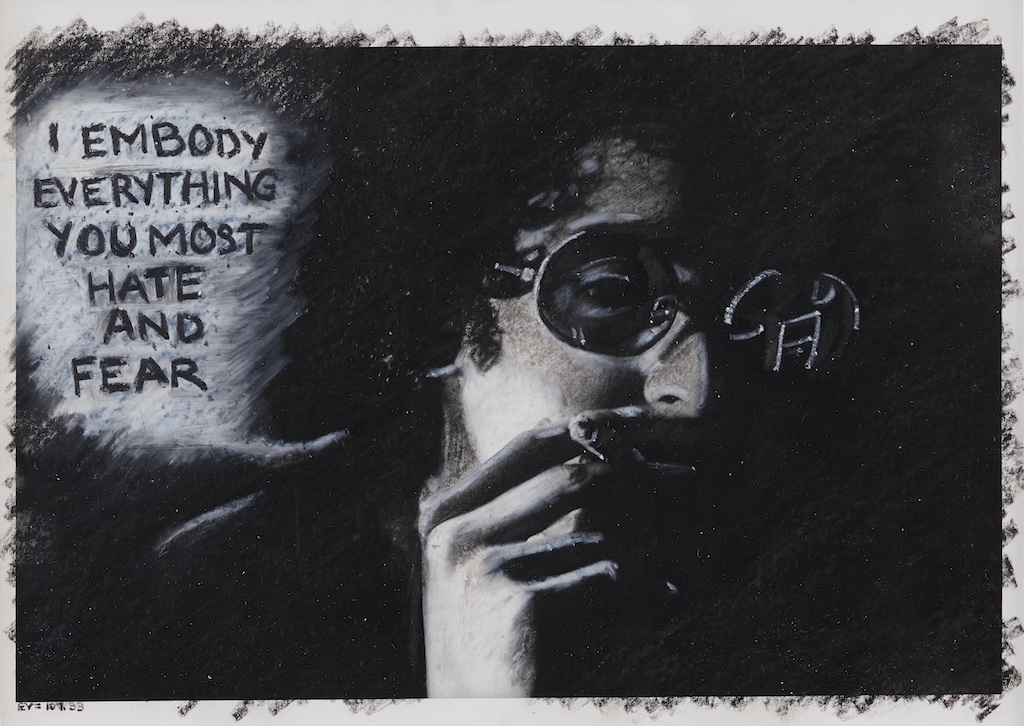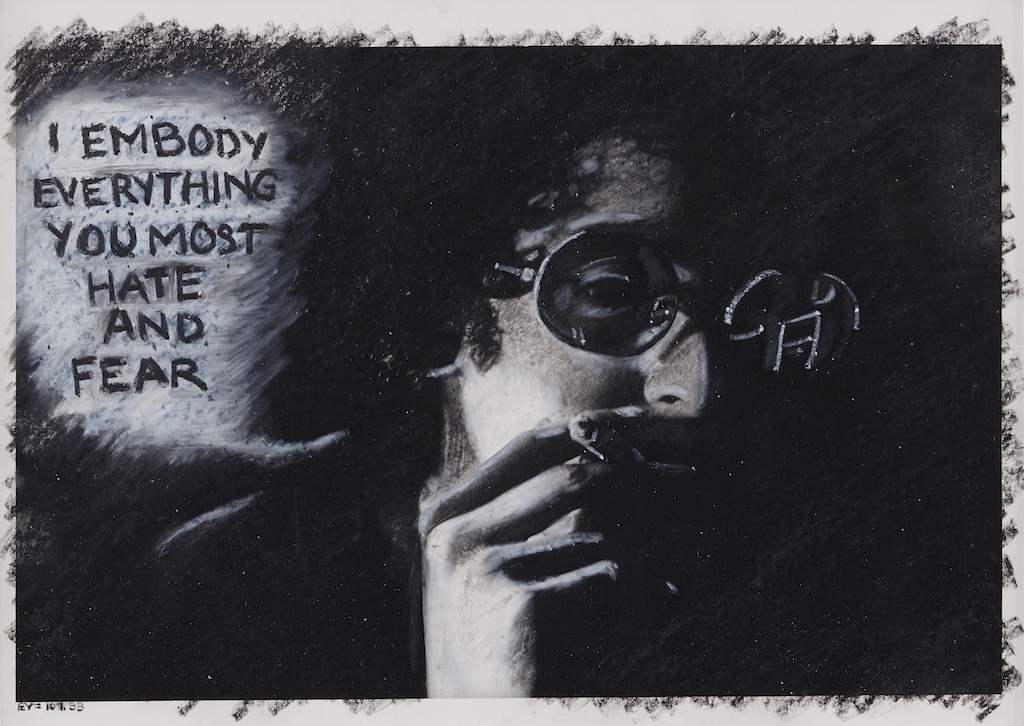[ad_1]

Adrian Piper, The Mythic Being: I Embody Everything You Most Hate and Fear, 1975, oil crayon on gelatin silver print.
©ADRIAN PIPER RESEARCH ARCHIVE FOUNDATION, BERLIN/COLLECTION THOMAS ERBEN, NEW YORK
Currently on view at the Museum of Modern Art in New York is a momentous 290-work Adrian Piper retrospective—a good occasion to look back through our archives for articles about the artist, whose work about race and gender continues to remain provocative today. Below are some findings, among them excerpts from articles about exhibitions involving Piper as well as a fragment from a statement about the meaning of feminism that she gave to ARTnews in 1997. —Alex Greenberger
“Black Artists Today: A Case of Exclusion”
By Patricia Failing
March 1989
Less well-known, especially among black audiences, are black artists who have been active in the fields of video, performance, and environmental installation. “Art as a Verb,” an exhibition co-curated by [Lowery Stokes] Sims and Leslie King-Hammond, dean of graduate studies at the Maryland Institute College of Art, was conceived to help rectify this art-historical gap. . . . This unprecedented show features the work of 13 “first generation” Afro-American artists who have explored video, performance, and installation in their work for the last ten years. These artists include [Faith] Ringgold, [David] Hammons, [Howardena] Pindell, [Betye] Saar, the late Charles Abramson, Maren Hassinger, Candace Hill, Martha Jackson-Jarvas, Senga Nengudi, Lorraine O’Grady, Adrian Piper, Joyce Scott, and Kaylynn Sullivan. . . . Contributions range from Hassinger’s expressionistic grouping of tree branches, Piper’s charcoal and crayon drawings on New York Times pages, and Pindell’s video drawings and videotape, Free, White and Twenty One, which reviews harrowing reactions to skin color. . . . “It is probably because full acceptance within the visual arts community is still eluding them that black artists have turned to performance and video art in particular,” Sims said. “Performance and video are so well suited to black expression in the arts that they seem almost stereotypical. All black Americans have to ‘perform’ in some way or another in this society on a daily basis to survive.”
“Los Angeles: Artists Protest Sponsorship”
February 1996
The first major museum survey of Conceptual art, “1965–1975: Reconsidering the Object of Art,” at the Museum of Contemporary Art, has been acclaimed by critics but plagued by complaints from its participants. Eleven of the 55 artists represented and catalogue essayist Lucy Lippard have belatedly protested Phillip Morris’s sponsorship claiming they didn’t know about the tobacco company’s involvement when the show was organized.
Hans Haacke led the salvo just prior to the opening last fall with a letter to the museum’s director, Richard Koshalek, citing the health hazards of smoking and charging that Philip Morris “should not have the privilege of being associated with this event.” The museum posted the letter adjacent to Haacke’s work in the show.
A week later, the museum placed a notice under Haacke’s letter adding the objections of Lippard and the artists, who include Dan Graham, Sol LeWitt, and Yvonne Rainer. Adrian Piper, a Boston-based Conceptual artist, asked that her work be removed and photographs of her painters, who died from smoking-related diseases, be substituted. The museum removed her ten pieces but declined the substitution.
Excerpt from Adrian Piper statement from “Weighing in on Feminism”
By Carey Lovelace
May 1997
Most of my work deals with race and xenophobia. Some work is about gender and forms of oppression of women, but mostly it’s about race. I think the way feminism affected the content of my work was by giving me an even stronger sense of the importance of what I was doing. Invariably, if you do that kind of work, you get a lot of flack, disapproval, and punishment from people. And then the question is: are you wrong and crazy, or are they? I think through my exposure to feminism, I was schooled in how to understand power dynamics.
“Adrian Piper Pulls Out of Black Performance-Art Show“
By Robin Cembalest
October 25, 2013
Footage from Mythic Being, borrowed from Kennedy, had been playing on a monitor in the Grey’s galleries [at “Radical Presence: Black Performance in Contemporary Art”] until this week—when Piper requested the work be removed. The monitor was turned off and the gallery posted a note to viewers on top.
It explained that the artist had articulated her reasons in correspondence with Valerie Cassel Oliver, the show’s curator, which reads in part:
“I appreciate your intentions. Perhaps a more effective way to ‘celebrate [me], [my] work and [my] contributions to not only the art world at large, but also a generation of black artists working in performance,’ might be to curate multi-ethnic exhibitions that give American audiences the rare opportunity to measure directly the groundbreaking achievements of African American artists against those of their peers in ‘the art world at large.’”
The note responds with a statement of Cassel Oliver’s from the catalogue, arguing that the show’s mission is to resist “reductive conclusions about blackness: what it is or what it ain’t. What is clear is that it exists and has shaped and been shaped by experiences. The artists in this exhibition have defied the ‘shadow’ of marginalization and have challenged both the establishment and at times their own communities.”
“Armenia, Adrian Piper Win Venice Biennale’s Golden Lions“
May 9, 2015
This afternoon, at a ceremony in the Most Serene Republic, the organizers of the Venice Biennale announced the full slate of winners for this, the 56th edition of the exhibition. Adrian Piper and Armenia took home Golden Lions, the top honors—Piper in connection with her participation in Owkui Enwezor’s central show, “All the World’s Future,” and Armenia for its offsite pavilion on the Island of San Lazzaro, which includes the work of Mher Azatyan, Grigor Khachatryan, and Astghik Melkonyan.
“Piper has reformed conceptual practice to include personal subjectivity—of herself, her audience, and the publics in general,” the jury said in a statement. Piper presented an interactive piece in Enwezor’s show that asked visitors to sign written contracts with themselves to agree to one of three publicly posted statements, like “I will always do what I say I am going to do.” Her work, they wrote, “invite us to to engage in a lifelong performance of personal responsibility.”
[ad_2]
Source link

